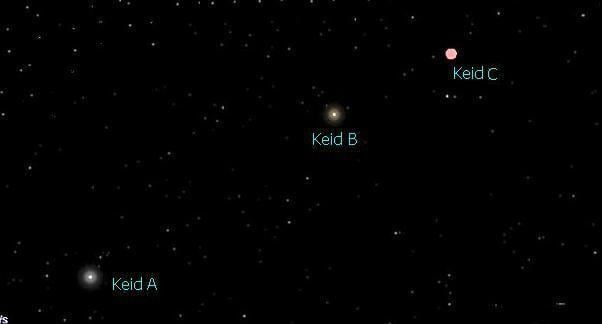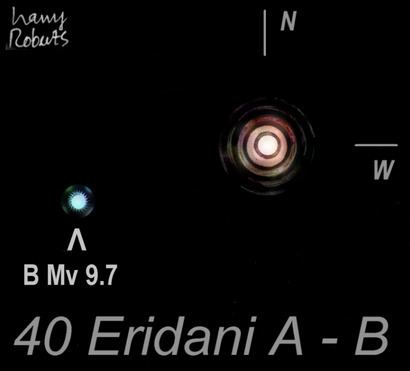Companion 40 Eridani BC | Companion 40 Eridani C | |
40 Eridani (abbreviated 40 Eri), also designated Omicron² Eridani (ο² Eridani, abbreviated Omicron² Eri, ο² Eri) is a triple star system less than 16.5 light years away from Earth, in the constellation of Eridanus.
Contents
- Lena habla de keid 40 eridani mucha ternura en san cayetano
- Nomenclature
- Properties
- Potential for life
- References
The primary star of the system, designated 40 Eridani A, also named Keid, is easily visible to the naked eye. It is orbited by a binary system whose two components are designated 40 Eridani B and C, and which were discovered on January 31, 1783, by William Herschel., p. 73 It was again observed by Friedrich Struve in 1825 and by Otto Struve in 1851.

In 1910, it was discovered that although component B was a faint star, it was white in color. This meant that it had to be a small star; in fact it was a white dwarf, the first discovered. Although it is neither the closest white dwarf, nor the brightest in the night sky, it is by far the easiest to observe; it is nearly three magnitudes brighter than Van Maanen's Star (the nearest solitary white dwarf), and unlike the companions of Procyon and Sirius it is not swamped in the glare of a much brighter primary.

Lena habla de keid 40 eridani mucha ternura en san cayetano
Nomenclature
40 Eridani is the system's Flamsteed designation and ο² Eridani (Latinised to Omicron² Eridani) its Bayer designation. The designations of the sub-components - 40 Eridani A, B and C - derive from the convention used by the Washington Multiplicity Catalog (WMC) for multiple star systems, and adopted by the International Astronomical Union (IAU). 40 Eridani C also bears the variable star designation DY Eridani.

40 Eridani A's traditional name Keid derives from the Arabic word qayd meaning "(egg) shells". In 2016, the IAU organized a Working Group on Star Names (WGSN) to catalogue and standardize proper names for stars. The WGSN approved the name Keid for this star on 12 September 2016 and it is now so entered in the IAU Catalog of Star Names.
Properties
40 Eridani A is a main-sequence dwarf of spectral type K1. 40 Eridani B and C, are a 9th magnitude white dwarf (spectral type DA4) and an 11th magnitude red dwarf flare star (spectral type M4.5e), respectively. Presumably, while B was a main-sequence star, it was the most massive member of the system, but ejected most of its mass before it became a white dwarf. B and C orbit each other approximately 400 AU from the primary star, A. Their orbit has a semimajor axis of 35 AU (which is the approximate average distance between B and C) and is rather elliptical (eccentricity 0.410).
As seen from the 40 Eridani system, the Sun is a 3.4-magnitude star in Hercules, near the border with Serpens Caput.
Potential for life
The primary component has a metallicity of [Fe/H]=−0.19, i.e. about 65 percent of the solar metallicity, thus providing a probably sufficient heavy element abundance for the formation of terrestrial planets. However, no planet orbiting a member of 40 Eridani is known so far.
The habitable zone of 40 Eridani A, where a planet could exist with liquid water, is near 0.68 (calculated from habitable zone) AU from A. At this distance a planet would complete a revolution in 223 Earth days (according to the third Kepler's law) and 40 Eridani A would appear nearly 20% wider than the Sun does on Earth. An observer on a planet in the 40 Eridani A system would see the B/C pair as unusually bright (magnitudes -8 and -6) white and reddish-orange stars in the night sky. This is not bright enough to diminish the darkness at night, though they would be visible in daylight (assuming an Earth-normal atmosphere). (By comparison, Earth's full moon is magnitude −12.6, and Venus at its brightest is −4.7.)
It is extremely unlikely that habitable planets exist around the B star because planets circling 40 Eridani B would probably have been destroyed or sterilized by its evolution into a white dwarf. As for 40 Eridani C, it is prone to flares, which cause large momentary increases in the emission of X-rays as well as visible light. This would be lethal to Earth-type life on planets near the flare star.
